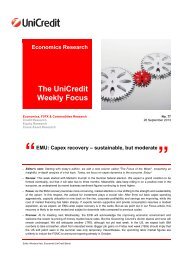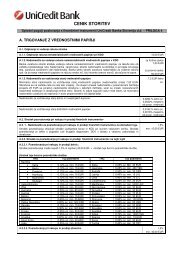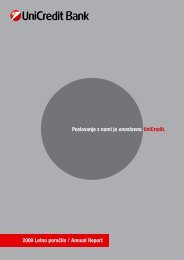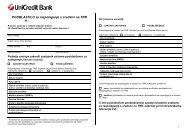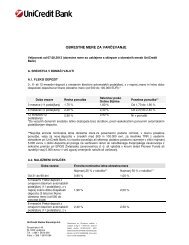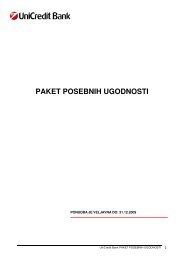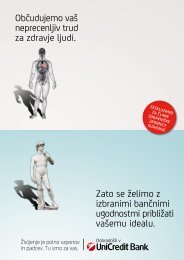Letno poroÄilo 2007 - UniCredit Banka Slovenija dd
Letno poroÄilo 2007 - UniCredit Banka Slovenija dd
Letno poroÄilo 2007 - UniCredit Banka Slovenija dd
You also want an ePaper? Increase the reach of your titles
YUMPU automatically turns print PDFs into web optimized ePapers that Google loves.
Business ReportEconomic Environment in <strong>2007</strong>After the strong growth of the Slovenianeconomy in 2006 (5.2 %), the growthin <strong>2007</strong> was even higher (roughly 6 %),so the economy experienced the highesteconomic growth since the country’sindependence. High growth was fuelled byexports and the construction sector, whichin <strong>2007</strong> experienced better than anticipatedconditions. The year <strong>2007</strong> was marked bynumerous reforms including: adoption of theeuro, tax reforms, continued privatization ofstate-owned companies and deregulationof the electricity market. However, theirpositive impact on the economy is yet to beseen.For the year 2008, ease of economic growthis expected due to reduced economicgrowth of main European trading partners,lower growth in domestic consumption andinvestments due to higher inflation forecaststhat have been building during the secondhalf of <strong>2007</strong> as well as the higher cost offinancing resulting from the credit crisis inglobal financial markets. Nevertheless, weexpect the trend of sound public financesand positive developments in the labourmarket to continue.On the demand side of strong economicgrowth in <strong>2007</strong>, the most importantcomponent of growth was lively investmentactivity, in particular gross investmentsinto fixed assets growing by roughly 17 %annually and driven by high debt financingand good weather conditions. The growthof lending to non-banking sector reachedroughly 32 %. This robust growth in lendingis on one hand related to strong growth ofthe economy, lively activity in constructionssector, still relatively favourable interestrates and favourable effects of the taxlegislation changes on household income.Lending activity to non-banking sector alsoresulted in altered structure of the Bank’sbalance sheet towards higher share of loansto this sector to roughly 64 % of total assetswith further growth tendency.On the other hand, private consumption hasslowed to 2.7 %. The biggest contributorto private consumption was the real growthof salary net expenses (7.7 %), which waspartially caused by the tax reform and byhigher employment rates. At the same time,the unemployment rate fell to the lowestlevel so far, to 4.5 % as measured by ILOstandards. Public consumption experiencedthe same trend as private consumption,namely a slower annual growth compared tothe last year.Net exports had a negative impact on GDPgrowth because high growth of exports wasaccompanied by an even higher growth ofimports thus having a negative impact onthe current account deficit that widened to3.4 % of GDP.Strong expansion of industry and highproductivity continued and reached roughly10 % and 8 % respectively. They arethus considered the strongest generatorsof economic growth. The expansionin construction was marked also byexceptionally high growth of gross valuea<strong>dd</strong>ed (17 %), accompanied by high growthin financial services (15 %), public servicesand trade in motor vehicles.Inflation has risen to 5.6 % in <strong>2007</strong>compared to 2.8 % the previous year (whilethe average inflation was 3.6 %), whichcan be explained by a rise in energy coststhat pushed inflation higher by 0.9 basepoints, a rise in food prices (2.2 basepoints), services and euro adoption (0.3base points). The economy has successfullydefied the hike in energy and metals pricesas an effect of geopolitical tensions, highdemand from China and the hike in grainsprices. When commodities were pricedhigher in the final products, namely foodand services, the inflationary expectationsrose and demands for higher wages haveemerged at home as well as in otherEuropean countries.Apart from inflation, <strong>2007</strong> also will beremembered for the crisis in sub-primemortgage lending in the USA that has forcedmany banks and other financial investors towrite off significant amounts of their assets.This has caused banks to re-evaluate creditrisk and become reluctant to lend to eachMacroeconomic indicators for Slovenia, 2002 to <strong>2007</strong>2002 2003 2004 2005 2006 <strong>2007</strong>GDP (growth in %) 3.5 2.7 4.4 4.0 5.2 6.0Inflation (annual average in %) 7.5 5.6 3.6 2.5 2.8 3.6Public external debt (in % of GDP) 29.1 28.7 29.0 28.4 27.1 25.6Budget deficit (in % of GDP) -2.5 -2.8 -2.3 -1.5 -1.2 -Unemployment rate by ILO standards 6.4 6.7 6.3 6.5 6.0 4.5Source: Bank of Slovenia<strong>UniCredit</strong> Bank · <strong>2007</strong> Annual Report 115



